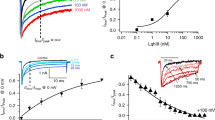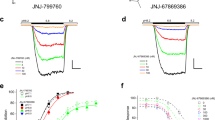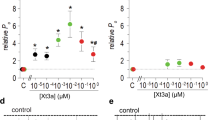Abstract
Venomous animals produce small protein toxins that inhibit ion channels with high affinity. In several well-studied cases the inhibitory proteins are water-soluble and bind at a channel's aqueous-exposed extracellular surface1,2,3,4. Here we show that a voltage-sensor toxin (VSTX1) from the Chilean Rose Tarantula (Grammostola spatulata) reaches its target by partitioning into the lipid membrane. Lipid membrane partitioning serves two purposes: to localize the toxin in the membrane where the voltage sensor resides and to exploit the free energy of partitioning to achieve apparent high-affinity inhibition. VSTX1, small hydrophobic poisons and anaesthetic molecules reveal a common theme of voltage sensor inhibition through lipid membrane access. The apparent requirement for such access is consistent with the recent proposal that the sensor in voltage-dependent K+ channels is located at the membrane–protein interface5,6.
This is a preview of subscription content, access via your institution
Access options
Subscribe to this journal
Receive 51 print issues and online access
$199.00 per year
only $3.90 per issue
Buy this article
- Purchase on Springer Link
- Instant access to full article PDF
Prices may be subject to local taxes which are calculated during checkout




Similar content being viewed by others
References
Miller, C., Moczydlowski, E., Latorre, R. & Phillips, M. Charybdotoxin, a protein inhibitor of single Ca2+-activated K+ channels from mammalian skeletal muscle. Nature 313, 316–318 (1985)
Hidalgo, P. & MacKinnon, R. Revealing the architecture of a K+ channel pore through mutant cycles with a peptide inhibitor. Science 268, 307–310 (1995)
Imredy, J. P., Chen, C. & MacKinnon, R. A snake toxin inhibitor of inward rectifier potassium channel ROMK1. Biochemistry 37, 14867–14874 (1998)
Hugues, M., Romey, G., Duval, D., Vincent, J. P. & Lazdunski, M. Apamin as a selective blocker of the calcium-dependent potassium channel in neuroblastoma cells: voltage-clamp and biochemical characterization of the toxin receptor. Proc. Natl Acad. Sci. USA 79, 1308–1312 (1982)
Jiang, Y., Ruta, V., Chen, J., Lee, A. & MacKinnon, R. The principle of gating charge movement in a voltage-dependent K+ channel. Nature 423, 42–48 (2003)
Jiang, Y. et al. X-ray structure of a voltage-dependent K+ channel. Nature 423, 33–41 (2003)
Miller, C. Diffusion-controlled binding of a peptide neurotoxin to its K+ channel receptor. Biochemistry 29, 5320–5325 (1990)
Escobar, L., Root, M. J. & MacKinnon, R. Influence of protein surface charge on the bimolecular kinetics of a potassium channel peptide inhibitor. Biochemistry 32, 6982–6987 (1993)
Goldstein, S. A., Pheasant, D. J. & Miller, C. The charybdotoxin receptor of a Shaker K+ channel: peptide and channel residues mediating molecular recognition. Neuron 12, 1377–1388 (1994)
Ranganathan, R., Lewis, J. H. & MacKinnon, R. Spatial localization of the K+ channel selectivity filter by mutant cycle-based structure analysis. Neuron 16, 131–139 (1996)
Swartz, K. J. & MacKinnon, R. Hanatoxin modifies the gating of a voltage-dependent K+ channel through multiple binding sites. Neuron 18, 665–673 (1997)
Swartz, K. J. & MacKinnon, R. Mapping the receptor site for hanatoxin, a gating modifier of voltage-dependent K+ channels. Neuron 18, 675–682 (1997)
Swartz, K. J. & MacKinnon, R. An inhibitor of the Kv2.1 potassium channel isolated from the venom of a Chilean tarantula. Neuron 15, 941–949 (1995)
Ruta, V., Jiang, Y., Lee, A., Chen, J. & MacKinnon, R. Functional analysis of an archeabacterial voltage-dependent K+ channel. Nature 422, 180–185 (2003)
Winterfield, J. R. & Swartz, K. J. A hot spot for the interaction of gating modifier toxins with voltage-dependent ion channels. J. Gen. Physiol. 116, 637–644 (2000)
Li-Smerin, Y. & Swartz, K. J. Gating modifier toxins reveal a conserved structural motif in voltage- gated Ca2+ and K+ channels. Proc. Natl Acad. Sci. USA 95, 8585–8589 (1998)
Lee, C. W. et al. Solution Structure and Functional Characterization of SGTx1, a Modifier of Kv2.1 Channel Gating. Biochemistry 43, 890–897 (2004)
Takahashi, H. et al. Solution structure of hanatoxin1, a gating modifier of voltage-dependent K(+ ) channels: common surface features of gating modifier toxins. J. Mol. Biol. 297, 771–780 (2000)
Manoleras, N. & Norton, R. S. Three-dimensional structure in solution of neurotoxin III from the sea anemone Anemonia sulcata. Biochemistry 33, 11051–11061 (1994)
Wang, J. et al. Functional mapping of the molecular surface of a gating modifier toxin for voltage-gated K+ channels. Biophys. J. 84, 218a (2003)
Lee, H. C., Wang, J. M. & Swartz, K. J. Interaction between extracellular Hanatoxin and the resting conformation of the voltage-sensor paddle in Kv channels. Neuron 40, 527–536 (2003)
Jiang, Q. X. Spherical reconstruction: a novel method for structure determination from cryo-EM images of membrane proteins in small vesicles. Thesis, Yale Univ. (2001)
Garcia, M. L., Garcia-Calvo, M., Hidalgo, P., Lee, A. & MacKinnon, R. Purification and characterization of three inhibitors of voltage-dependent K+ channels from Leiurus quinquestriatus var. hebraeus venom. Biochemistry 33, 6834–6839 (1994)
Ladokhin, A. S., Jayasinghe, S. & White, S. H. How to measure and analyze tryptophan fluorescence in membranes properly, and why bother? Anal. Biochem. 285, 235–245 (2000)
Almeida, P. F. F. & Vaz, W. L. C. in Handbook of Biological Physics (eds Lipowsky, R. & Sackmann, E.) 305–357 (Elsevier Science, Netherlands, 1995)
Schurr, J. M. The role of diffusion in enzyme kinetics. Biophys. J. 10, 717–727 (1970)
Hille, B. Ion Channels of Excitable Membranes 635–662 (Sinauer Associates, Sunderland, MA, 2001)
Heginbotham, L., LeMasurier, M., Kolmakova-Partensky, L. & Miller, C. Single streptomyces lividans K(+ ) channels: functional asymmetries and sidedness of proton activation. J. Gen. Physiol. 114, 551–560 (1999)
Diochot, S., Drici, M. D., Moinier, D., Fink, M. & Lazdunski, M. Effects of phrixotoxins on the Kv4 family of potassium channels and implications for the role of Ito1 in cardiac electrogenesis. Br. J. Pharmacol. 126, 251–263 (1999)
Escoubas, P., Diochot, S., Celerier, M. L., Nakajima, T. & Lazdunski, M. Novel tarantula toxins for subtypes of voltage-dependent potassium channels in the Kv2 and Kv4 subfamilies. Mol. Pharmacol. 62, 48–57 (2002)
Acknowledgements
We thank D. King for toxin synthesis for initial experiments, F. Valiyaveetil for help with fluorescence experiments, V. Ruta for help with toxin purification and electrophysiology and S. Long for providing AgTx2. This work was supported by a National Institutes of Health grant to R.M. R.M. is an investigator in the Howard Hughes Medical Institute.
Author information
Authors and Affiliations
Corresponding author
Ethics declarations
Competing interests
The authors declare that they have no competing financial interests.
Rights and permissions
About this article
Cite this article
Lee, SY., MacKinnon, R. A membrane-access mechanism of ion channel inhibition by voltage sensor toxins from spider venom. Nature 430, 232–235 (2004). https://doi.org/10.1038/nature02632
Received:
Accepted:
Issue Date:
DOI: https://doi.org/10.1038/nature02632
This article is cited by
-
Membrane-mediated interaction of non-conventional snake three-finger toxins with nicotinic acetylcholine receptors
Communications Biology (2022)
-
Ligand binding at the protein–lipid interface: strategic considerations for drug design
Nature Reviews Drug Discovery (2021)
-
TRP Channels, Conformational Flexibility, and the Lipid Membrane
The Journal of Membrane Biology (2020)
-
Structural genomics applied to the rust fungus Melampsora larici-populina reveals two candidate effector proteins adopting cystine knot and NTF2-like protein folds
Scientific Reports (2019)
-
Differential Pd-nanocrystal facets demonstrate distinct antibacterial activity against Gram-positive and Gram-negative bacteria
Nature Communications (2018)
Comments
By submitting a comment you agree to abide by our Terms and Community Guidelines. If you find something abusive or that does not comply with our terms or guidelines please flag it as inappropriate.



